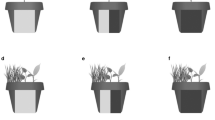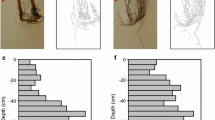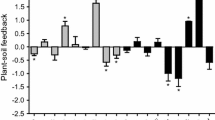Abstract
Spatial and temporal niche differentiation are potential mechanisms of plant species’ coexistence in many communities, including many grasslands. In a 6-year field experiment, a dominant prairie bunchgrass, Schizachyrium scoparium, excluded species sharing similar phenology and rooting depth, but coexisted with species differing in phenology and rooting depth. We used a series of experimental plots that differed in S. scoparium abundance to measure the effect of S. scoparium on abundances of other species and on soil nitrate concentrations across time and depth. Because we found that S. scoparium most strongly reduced soil nitrate levels at mid-season and at shallow depths, we hypothesized that at higher S. scoparium abundance, species with mid-season phenology and shallow roots would be excluded and that deep-rooted and early season species would be more likely to persist. As predicted, the proportional number and cover of species exploiting different niches than S. scoparium (early season and deep-rooted species) increased across the S. scoparium abundance gradient. This work provides novel empirical evidence for the factors that contribute to species coexistence in the field. Our study suggests that spatial and temporal niche differentiation promote species coexistence in these grasslands.



Similar content being viewed by others
References
Aarssen LW, Epp GA (1990) Neighbour manipulations in natural vegetation: a review. J Veg Sci 1:13–30
Armstrong RA, McGehee R (1980) Competitive exclusion. Am Nat 115:151–169
Bell G (2001) Neutral macroecology. Science 293:2413–2418
Berendse F (1979) Competition between plant populations with different rooting depths I. Theoretical considerations. Oecologia 43:19–26
Bratton SP (1976) Resource division in an understory herb community: responses to temporal and microtopographic gradients. Am Nat 110:679–693
Chesson P (1994) Multispecies competition in variable environments. Theor Popul Biol 45:227–276
Chesson P (2000) Mechanisms of maintenance of species diversity. Ann Rev Ecol Syst 31:343–366
Curtis JT (1959) Vegetation of Wisconsin. University of Wisconsin Press, Madison, Wisconsin
Fitter AH (1982) Influence of soil heterogeneity on the coexistence of grassland species. J Ecol 70:139–148
Fitter AH (1986) Spatial and temporal patterns of root activity in a species-rich alluvial grassland. Oecologia 69:594–599
Gibson DJ (1988) The maintenance of plant and soil heterogeneity in dune grassland. J Ecol 76:497–508
Goldberg DE, Barton AN (1992) Patterns and consequences of interspecific competition in natural communities: a review of field experiments with plants. Am Nat 139:771–801
Hubbell SP (2001) The unified neutral theory of biodiversity and biogeography. Princeton University Press, Princeton
Inouye, RS, Huntley NJ, Tilman D, Tester J, Stillwell M, and Zinnel K (1987) Old-field succession on a Minnesota sand plain. Ecology 68:12–26
Jackson RB, Canadell J, Ehleringer JR, Mooney HA, Sala OE, Schulze ED (1996) A global analysis of root distributions of terrestrial biomes. Oecologia 108:389–411
Mamolos AP, Veresoglou DS (2000) Patterns of root activity and responses of species to nutrients in vegetation of fertile alluvial soil. Plant Ecol 148:245–253
Mamolos AP, Elisseou GK, Veresoglou DS (1995) Depth of root activity of coexisting grassland species in relation to N and P additions, measured using radioactive tracers. J Ecol 83:643–652
McKane RB, Grigal DF, Russelle MP (1990) Spatiotemporal differences in 15N uptake and the organization of an old-field plant community. Ecology 71:1126–1132
McKane RB, Johnson LC, Shaver GR, Nadelhoffer KJ, Rastetter EB, Fry B, Giblin AE, Kielland K, Kwiatkowski BL, Laundre JA, Murray G (2002) Resource-based niches provide a basis for plant species diversity and dominance in artic tundra. Nature 415:68–71
Parrish JAD, Bazzaz FA (1976) Underground niche separation in successional plants. Ecology 57:1281–1288
SAS Institute Inc. (2001) JMP 4.0.4. Cary, NC, USA
Schoener TW (1983) Field experiments on interspecific competition. Am Nat 122:240–285
Sun GW, Coffin DP, Lauenroth WK (1997) Comparison of root distributions of species in North American grasslands using GIS. J Veg Sci 8:587–596
Tilman D (1988) Plant strategies and the dynamics and structure of plant communities. Princeton University Press, Princeton
Tilman D (1989) Competition, nutrient reduction and the competitive neighborhood of a bunchgrass. Funct Ecol 3:215–219
Tilman D (1990) Constraints and tradeoffs: toward a predictive theory of competition and succession. Oikos 58:3–15
Tilman D, Wedin D (1991) Plant traits and resource reduction for five grasses growing on a nitrogen gradient. Ecology 72:685–700
Veresoglou DS, Fitter AH (1984) Spatial and temporal patterns of growth and nutrient uptake of five co-existing grasses. J Ecol 72:259–272
Weaver JE (1958) Classification of root systems of forbs of grassland and a consideration of their significance. Ecology 39:393–401
Wedin DA, Tilman D (1990) Species effect on nitrogen cycle: a test with perennial grasses. Oecologia 84:433–441
Wedin D, Tilman D (1993) Competition among grasses along a nitrogen gradient: initial conditions and mechanisms of competition. Ecol Monogr 63:199–229
Wilson SD, Tilman D (1993) Plant competition and resource availability in response to disturbance and fertilization. Ecology 74:599–611
Wright SJ (2002) Plant diversity in tropical forests: a review of mechanisms of species coexistence. Oecologia 130:1–14
Yeaton RI, Travis J Gilinsky E (1977) Competition and spacing in plant communities: the Arizona upland association. J Ecol 65:587–595
Acknowledgements
We thank Troy Mielke and Stan Harpole for help in the field, Olivia Damon for chemical analysis, Dennis Cook for statistical advice, and the two anonymous reviewers for insightful comments. The experiments performed here comply with the current laws of the country in which they were performed.
Author information
Authors and Affiliations
Corresponding author
Additional information
Communicated by Rowan Sage
Appendix
Appendix
The appendix lists species found in the study and their phenology and rooting depth classification. B/P indicates species that exhibit both biennial and perennial life history at Cedar Creek Natural History Area. W. Annual indicates winter annual species, which germinate in the fall, overwinter as seedlings, and in the summer produce seed that germinates during the same growing season.
Species | Phenology | Rooting depth | Photo-synthetic pathway | Number of plots present | Life history |
|---|---|---|---|---|---|
Agropyron repens | Early | Deep | C3 | 28 | Perennial |
Berteroa incana | Early | Deep | C3 | 12 | B/P |
Lychnis alba | Early | Deep | C3 | 16 | B/P |
Poa pratensis | Early | Deep | C3 | 14 | Perennial |
Polygonum convolvulus | Early | Deep | C3 | 16 | Annual |
Rudbeckia serotina | Early | Deep | C3 | 4 | B/P |
Vicia villosa | Early | Deep | C3 | 21 | W. annual |
Agrostis alba | Early | Shallow | C3 | 4 | Perennial |
Agrostis scabra | Early | Shallow | C3 | 2 | Perennial |
Crepis tectorum | Early | Shallow | C3 | 2 | Biennial |
Hedeoma hispida | Early | Shallow | C3 | 14 | Annual |
Lepidium densiflorum | Early | Shallow | C3 | 8 | W. annual |
Oxalis stricta | Early | Shallow | C3 | 2 | Perennial |
Rumex acetosella | Early | Shallow | C3 | 3 | Perennial |
Silene antirrhina | Early | Shallow | C3 | 4 | Annual |
Andropogon gerardi | Mid | Deep | C4 | 4 | Perennial |
Asclepias syriaca | Mid | Deep | C3 | 3 | Perennial |
Erigeron canadensis | Mid | Deep | C3 | 4 | W. annual |
Monarda fistulosa | Mid | Deep | C3 | 11 | Perennial |
Panicum oligosanthes | Mid | Deep | C4 | 2 | Perennial |
Petalostemum candidum | Mid | Deep | C3 | 1 | Perennial |
Sorghastrum nutans | Mid | Deep | C4 | 1 | Perennial |
Verbascum thapsus | Mid | Deep | C3 | 3 | Biennial |
Ambrosia artemisiifolia | Mid | Shallow | C3 | 14 | Annual |
Digitaria ischaemum | Mid | Shallow | C4 | 13 | Annual |
Setaria lutescens (glauca) | Mid | Shallow | C4 | 10 | Annual |
Rights and permissions
About this article
Cite this article
Fargione, J., Tilman, D. Niche differences in phenology and rooting depth promote coexistence with a dominant C4 bunchgrass. Oecologia 143, 598–606 (2005). https://doi.org/10.1007/s00442-005-0010-y
Received:
Revised:
Published:
Issue Date:
DOI: https://doi.org/10.1007/s00442-005-0010-y




